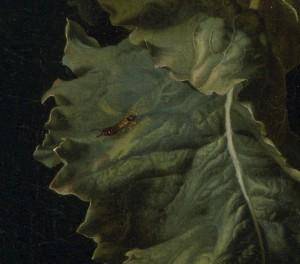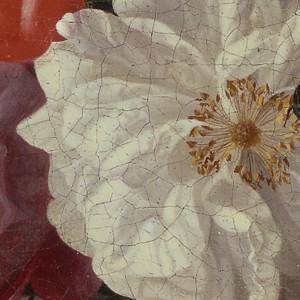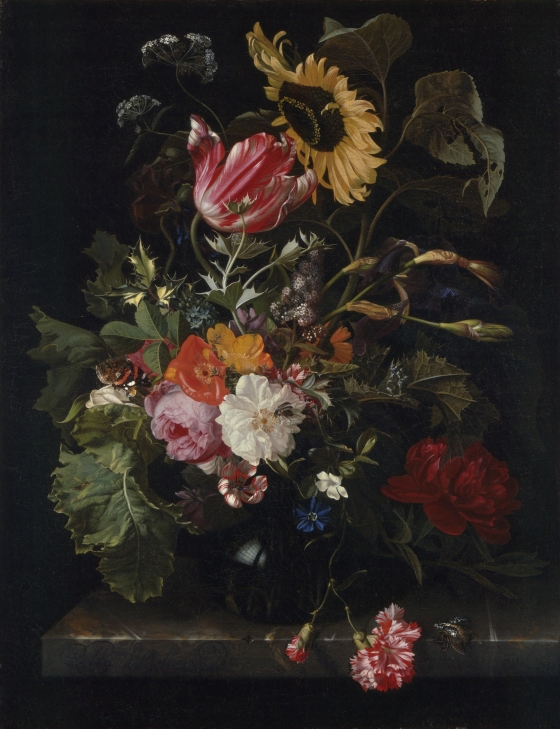Students will examine the artistic characteristics of Bouquet of Flowers in a Vase, learn about the historic and economic phenomenon known as Tulipomania, and conduct research and write a brief collective newspaper article about another financial bubble in history.
Students will be able to:
- examine the artistic characteristics of Bouquet of Flowers in a Vase;
- locate the Netherlands on a map of the world and identify some defining features of the country;
- describe the historic and economic phenomenon known as Tulipomania; and
- conduct research and write a brief collective newspaper article about another financial bubble in history.
Lesson
- Display Bouquet of Flowers in a Vase and invite students to look carefully and share what they observe. What do they notice about the painting? What flowers do they recognize? How many varieties do they see? Which ones do we see in our town/city today? Are all of the flowers in peak condition? What other living things can the students see in the painting? Share with students that Bouquet of Flowers in a Vase was created by Maria van Oosterwyck in Holland around 1670. Have students locate Holland, now known as the Netherlands, on a world map. Share some quick facts about Holland (e.g., geography, climate, languages, natural resources, government, history) by distributing or displaying information from appropriate websites, such as The World Factbook for the Netherlands.
- Explain to the students that the Dutch were enthusiastic about flowers during Oosterwyck’s time. Flowers like those in the bouquet were rare and very expensive in Holland. Flower bulbs and seeds had to be imported from the East, and only the wealthy could afford flower gardens. As a result, flowers, especially tulips, became symbols of status. Indeed, the 1630s in Holland encompassed a period of time known as “Tulipomania,” in which prices of tulips rose to extraordinary levels and then subsequently crashed, thus constituting the first major financial bubble. More information can be found on the following websites:
- Invite the students to think about economic bubbles during modern United States history, or in other cultures and time periods. What are some items that became very expensive at one point in time, and then dramatically decreased in price? Have the students share the names of these items and record their ideas on a (interactive) whiteboard or piece of chart paper. You may want to visit the following websites to spark the students’ thinking:
- Invite the students to share their thoughts about why these particular items increased dramatically in price. Why was there a high demand for these items? Was it their beauty, rarity, usefulness, or other factors? How did the supply and demand for these items compare with Tulipomania in Holland during the 1600s?
- Have students break into small research groups and select one of the items which demonstrated a significant rise and decrease in price. Invite students to conduct some brief research about their item, including why the item was in such demand, how much the price for the item increased and decreased, and what type of individuals were purchasing these items. Be sure that students have access to the Internet during class time, or you may want to download and/or assemble materials ahead of time.
- Invite each group of students to write a brief collective newspaper article from the perspective of someone a) at the peak of the bubble hype, or b) following the fall, which incorporates the information they have discovered about the item/phenomenon. Include information about the extremes people went to with this one product during the phenomenon.
- When students have finished their assignment, invite volunteers to share their work and display the students’ findings in the classroom.
Materials
- Lined paper and pen/pencil for each student
- Access to the Internet for the following websites:
- Prepared materials on other items that have been the focus of economic bubbles
- Piece of chart paper and colored markers or (interactive) whiteboard for recording students’ contributions
- Map of the world, visible to all students in the classroom
- About the Art section on Bouquet of Flowers in a Vase
- One color copy of the painting for every four students, or the ability to project the image onto a wall or screen
Standards
- Social Studies
- History
- Geography
- Evaluate and analyze sources using historical method of inquiry and defend their conclusions
- Understand the concept that the power of ideas is significant throughout history
- Become familiar with Western Hemisphere historical eras, groups, individuals and themes
- Analyze the concepts of continuity and change and effect
- Analyze the concept of complexity, unity and diversity
- Become familiar with United States historical eras, groups, individuals and themes
- Become familiar with World geography
- Understand geographic variables and how they affect people
- Visual Arts
- Observe and Learn to Comprehend
- Relate and Connect to Transfer
- Envision and Critique to Reflect
- Language Arts
- Oral Expression and Listening
- Research and Reasoning
- Writing and Composition
- Reading for All Purposes
- Collaboration
- Critical Thinking & Reasoning
- Information Literacy
- Invention
- Self-Direction
Bouquet of Flowers in a Vase
- Maria van Oosterwyck, Dutch, 1630-1693
Maria van Oosterwyck was born in Holland in 1630, the daughter of a well-to-do Protestant clergyman and his wife. She never married, though she was courted by another flower painter, Willem van Aelst. According to one source, van Aelst eventually gave up because she was so devoted to her career. Female artists were rare in the 1600s, but that didn’t keep Oosterwyck from success. Her paintings were bought by royalty, including King Louis XIV of France and King William III of England, and almost always fetched high prices.
Oosterwyck’s still-life studies included a range of objects such as glassware, coins, musical instruments, and flowers. She created complex images with lots of details, and was skilled at portraying light and reflections. She was particularly well-known for her flower paintings, and was able to capture the detail of individual flowers and foliage by sketching straight from the source. The bouquet in this painting would have been impossible to construct in real life because the flowers bloom in different seasons. Tulips, for example, bloom in the spring, while sunflowers bloom in the summer. Oosterwyck would have assembled this image of a fantasy bouquet from individual sketches she made in outdoor gardens.
During Oosterwyck’s time, the Dutch were crazy about flowers. Flowers were rare in Holland, and very expensive. Flower bulbs and seeds had to be imported from the East, and only the wealthy could afford flower gardens. As a result, flowers, especially tulips, became symbols of status.
Since only the wealthy could actually afford to buy flowers, flower paintings were a relatively “cheap” alternative and served a number of purposes. Flower paintings lasted longer than real blooms, and people enjoyed them as a reminder of spring during the cold Dutch winters. They also served as a demonstration of God’s bounty. Variety was especially valued in flower paintings—it was believed that only variety could make an image beautiful and delightful. Variety is achieved here through the portrayal of many different types of blossoms, the inclusion of foliage, the positioning of the flowers, and the inclusion of plants in different stages of growth and decay.
Details

Tulip & Sunflower
The devoutly religious Oosterwyck may have hidden a deeper meaning in our painting. In Oosterwyck’s time, flowers that turned their faces toward the sun were compared to faithful souls who followed God. Notice how the tulip bends around to face the sunflower. Huge sunflowers, with their rays of bright yellow petals, sometimes represented the sun. Some scholars have suggested that Oosterwyck was painting a faithful soul looking to God.

Decay
In the top right corner of the painting we see a leaf that has been eaten by insects. A white rose in the center of the bouquet is nearing the end of its life. Notice the small nick in the stone ledge upon which the bouquet sits. All of these things are signs of decay, and serve as reminders that all worldly things will die.

Reflection
Look closely at the vase and you will notice the reflection of a window.

Detailed Leaves
In each leaf we see individual veins, crisp edges, and the irregular coloration found in nature. During the 1600s, there was a keen interest in botany. Artists were often commissioned to illustrate botanical books and catalogues for flower sellers. Many of the people who bought flower paintings were wealthy gardeners who knew the anatomy of flowers well and wanted to see the botanical details.

Cracks
Covering the surface of the painting is a tiny network of cracks called craquelure. As paintings age, the paint or varnish will expand and contract with changes in temperature and humidity, and tiny cracks will begin to develop. Craquelure is seldom disfiguring and is simply regarded as a characteristic feature of older paintings.

Bugs
Look for butterflies, an earwig, a honeybee, and a beetle. The insects in this image are another indication of the 17th century fascination with the natural world.

Application of Paint
Oosterwyck applied the paint thinly, creating a smooth canvas. There are no ridges, lumps, or trails of paint to indicate Oosterwyck’s process. Notice how the red and white colors of the carnation do not merely exist side by side, but flow into one another gradually.
Funding for object education resources provided by a grant from the Morgridge Family Foundation. Additional funding provided by the William Randolph Hearst Endowment for Education Programs, and Xcel Energy Foundation. We thank our colleagues at the University of Denver Morgridge College of Education.
The images on this page are intended for classroom use only and may not be reproduced for other reasons without the permission of the Denver Art Museum. This object may not currently be on display at the museum.





